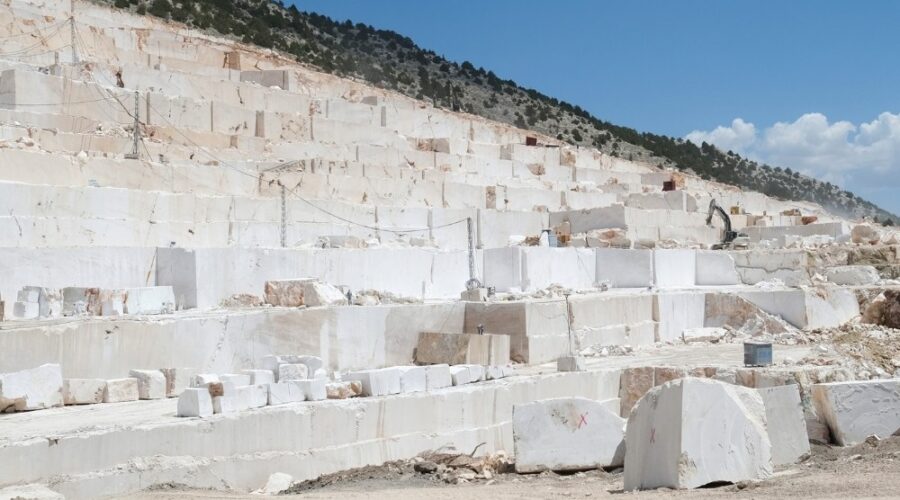Marble is a metamorphic rock. When limestone is subjected to high heat and pressures, it transforms into marble. When the calcite crystals in the limestone recrystallize, a denser rock with nearly equigranular calcite crystals emerges, a marble. A little quantity of impurity in the calcite during metamorphism results in a wide range of color variations in marble.
What is Marble?
Among the most sought-after stones for generations, marble has been adored by monarchs and craftspeople equally. When utilized in the household, marble gives a sense of richness and grandeur that can’t be denied. Calcite and dolomite are the most prevalent carbonate minerals that form marble. The majority of marble is not foliated; however, there are exceptions. When used in stonemasonry, the word “marble” refers to both metamorphosed and unmetamorphosed limestone.
The absence of color fluctuation within a particular stone sample is what we mean by purity. Even though some highly prize the presence of colorful veins, the finest marbles are nearly entirely white or extremely pale in comparison. Because of mineral wealth, the veining may be seen in the original limestone or when the limestone transforms into marble. “Veining” refers to the tendency of minerals to accumulate in distinct layers.
How Does Marble Form?
Convergent plate borders, where broad swaths of Earth’s crust are exposed to the heat and pressure of regional metamorphism, are the most common locations where limestone is transformed into marble. When a hot magma body warms nearby limestone, some marble is formed through contact metamorphism. The calcite in limestone is usually found in the form of lithified fossils and biological detritus before metamorphism. This calcite recrystallizes during metamorphism, and the texture of the rock changes as a result.
How Do You Recognize Marble?
The timeless beauty of marble may be seen in both residential and commercial structures. It might be difficult to identify the difference between genuine marble and imitations when looking at marble. It is possible to achieve the appearance and functionality of marble using modern imitation materials. There is elegance and purpose in manufactured marble, but you may want to know whether you’re looking at genuine marble. You’ll be able to spot marble more easily if you get familiar with its properties.
- Marble’s color ranges from pure white to black, although the natural stone is available in various delicate tones instead of striking hues. Pure white marble has no imperfections or impurities. Limestone may be colored green, yellow, pink, gray, cream, and even blue by combining with other naturally occurring minerals.
- Impurities in the limestone blend with the natural veins and swirls that appear in marble. Natural marble shows its imperfections in the form of lengthy, thick fibrous lines. While manufactured materials may mimic marble’s swirling and veined appearance, they lack the depth and complexity that come with the veining seen in nature.
- Real marble is made by heating limestone and producing calcite crystals, a mineral that’s quite soft. As a result, the marble’s surface is more susceptible to blemishes and damage than other materials. When it comes to sculptures and custom-shaped kitchen countertops, marble is a favorite because of its adaptability. If your stone has scuffs or other marks of use, it is made of authentic marble. To distinguish between real and artificial marble, you need to scrape a knife over an unnoticeable region of the slab or the underside and see little or no damage.
- True marble’s glossiness is one of its most attractive and distinguishing features. It cannot be stably duplicated. Glass and other finely crushed materials with a high gloss are included in the composition of synthetic stones used for kitchen countertops and other domestic surfaces. An initial high sheen may be achieved with this method, but it will not shine as brilliantly as highly polished real marble.
What Are The Physical Properties and Uses of Marble?
There are enormous marble quarries that may be hundreds of feet thick and spread over vast swathes of land. Large-scale mining is possible because certain mines and quarries can produce millions of tons of material each year. The majority of marble is turned into crushed stone or dimension stone. There are many uses for crushed stone, including the construction of roads and other infrastructure. Slicing marble into particular proportions produces dimension stone. Monuments, buildings, sculptures, pavement, and other construction projects use these dimensioned stone materials. Also, since ancient times, it has been utilized in sculpting and flooring.
- The visible crystals in marble give it a distinctive granular surface and look, but additional characteristics distinguish the rock.
- The primary components of marble are calcite, dolomite crystals, and aragonite.
• Even though its basic component, calcite, has a Mohs hardness of just three, marble is considered a robust and hard stone. A metal blade may be used to scrape marble. - Marble is often pale in color. White marble is the purest. Black marble is marble that includes a lot of bituminous substances. The majority of marble is light gray, pink, brown, green, yellow, or blue.
- It is possible to make marble fizz by exposing it to diluted hydrochloric acid.
- Gneiss and mica schists are common companions of this metamorphic rock.
- Marble may be polished to a high shine after being polished with finer abrasives.


